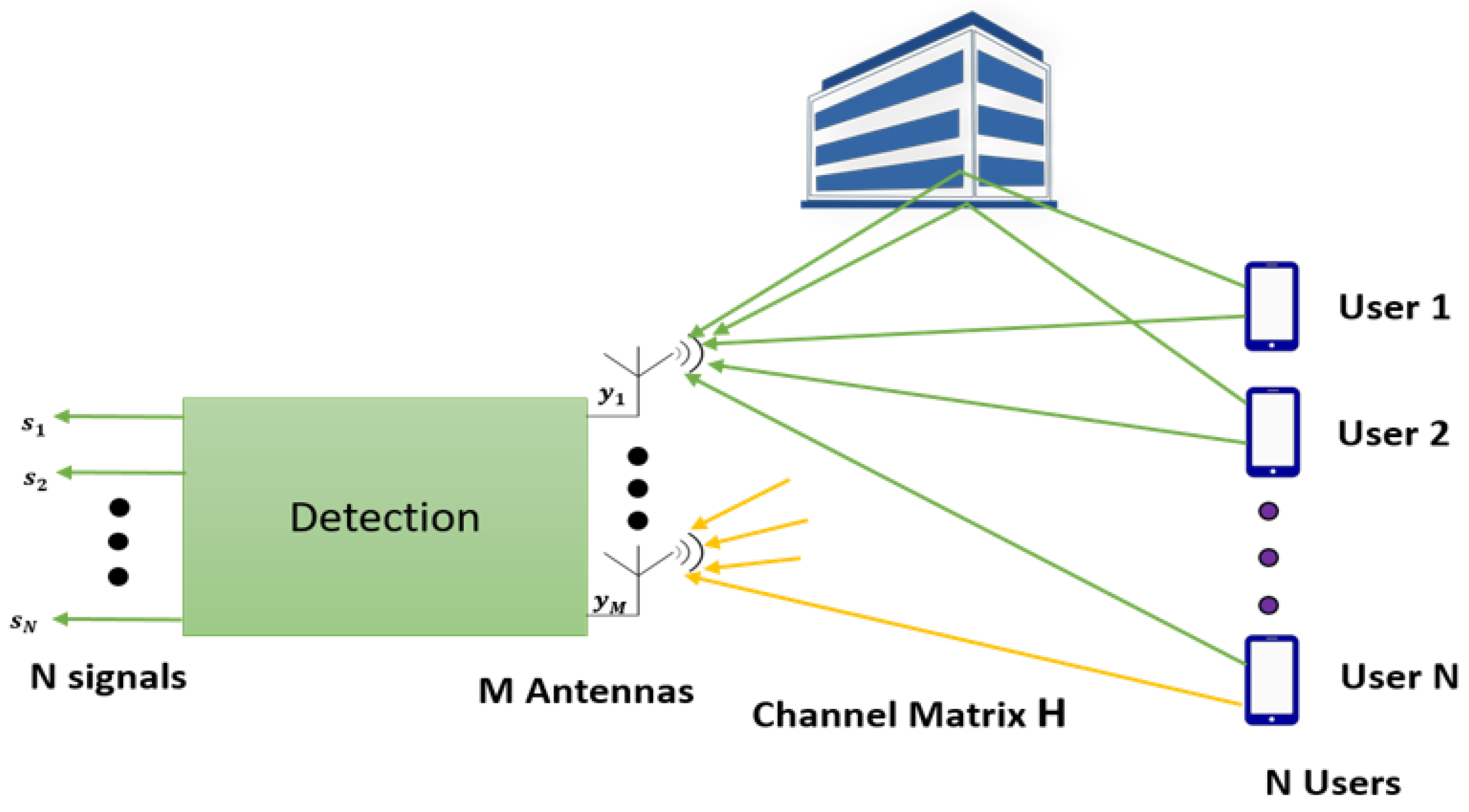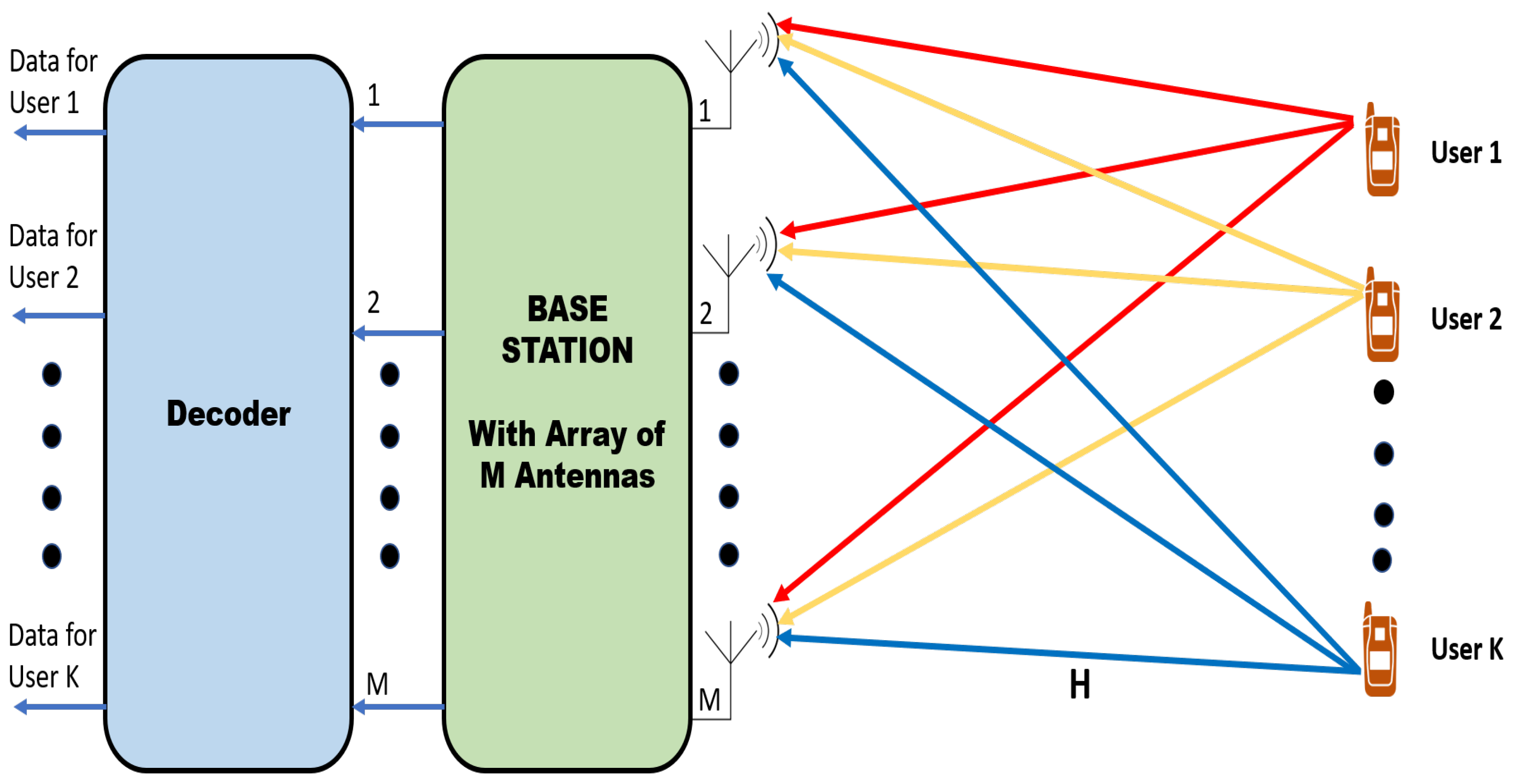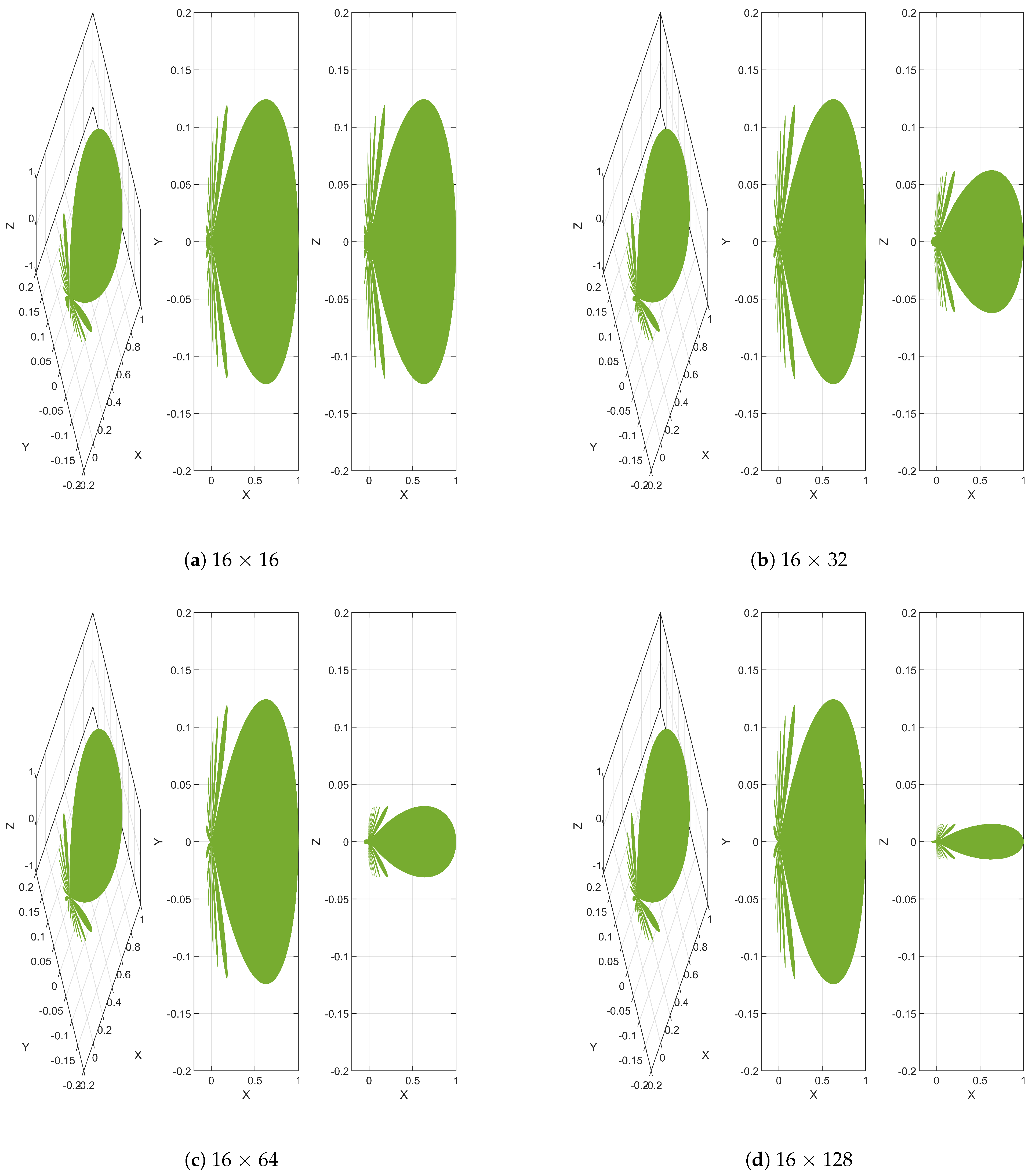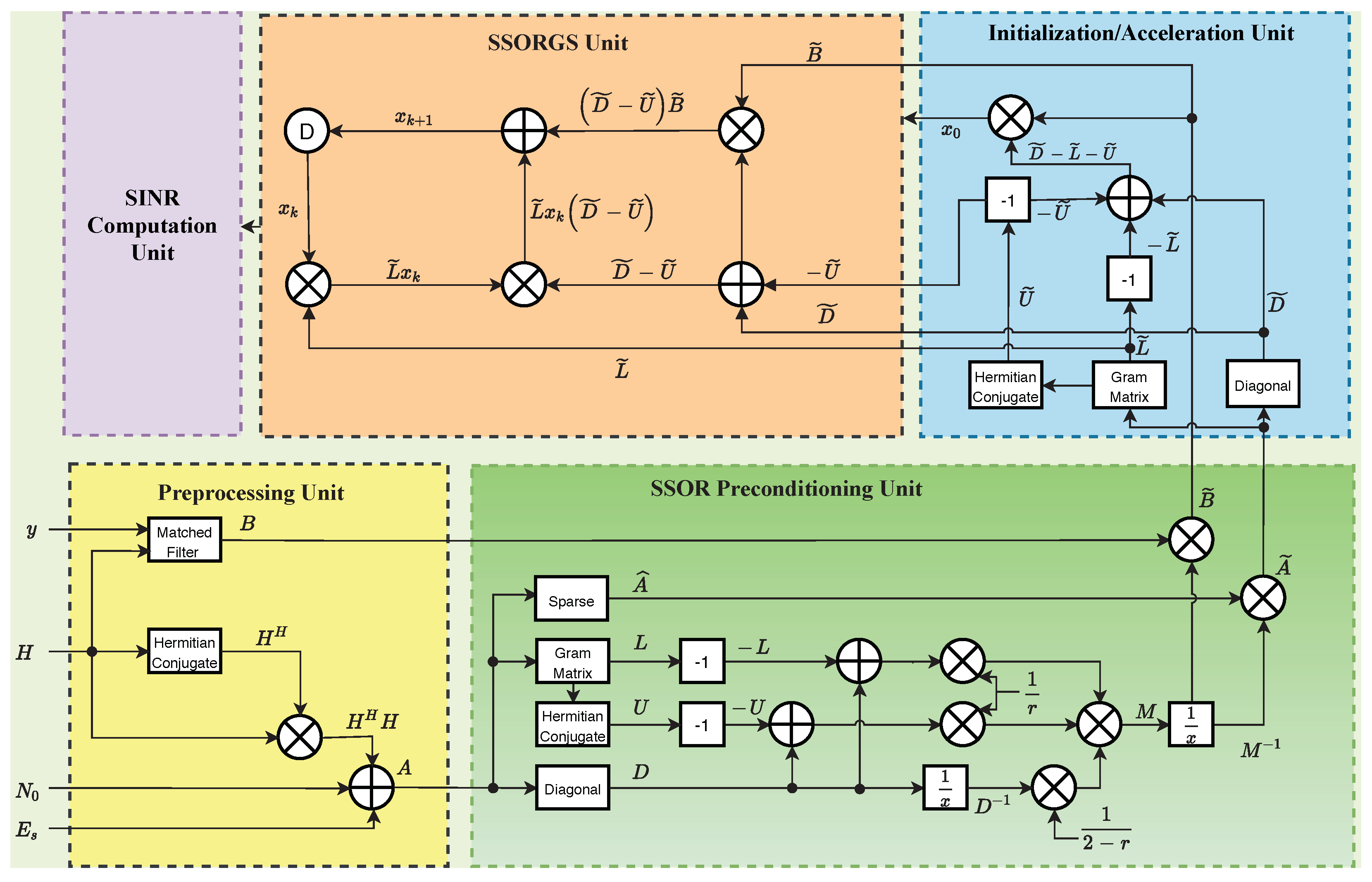SSOR Preconditioned Gauss-Seidel Detection and Its Hardware Architecture for 5G and beyond Massive MIMO Networks
Abstract
1. Introduction
1.1. Relevant Prior Art and Motivation
1.2. Contributions
- We study the uplink signal detection issue in the massive MIMO system. We propose an efficient iterative algorithm and its hardware architecture referred to as SSORGS to address the signal detection problem in the massive MIMO systems.
- We analyze the error performance and time complexity of the proposed SSORGS algorithm. We compare the performance of the SSORGS algorithm with the conventional algorithms such as CG, GS, ZF, MMSE, and ML.
- The results from the matlab simulation show that the proposed SSORGS algorithm outperforms the traditional iterative algorithms. The algorithm achieves near-optimal BER performance with acceptable computational complexity.
1.3. Paper Outline
1.4. Notations
2. System Model and Proposed Algorithm
2.1. System Model
2.2. Proposed Algorithm
| Algorithm 1 SSORGS Algorithm Proposed for Massive MIMO Uplink Singal Detection |
Inputs: Pre-processing:
Output: |
3. Simulation Setup and Simulation Results
3.1. Simulation Setup
3.2. Simulation Results
3.3. BER Performance
4. Hardware Architecture and Complexity Analysis
5. Conclusions
Author Contributions
Funding
Conflicts of Interest
Abbreviations
| MIMO | Multiple-input multiple-output |
| SSOR | Successive Over-relaxation preconditioner |
| SSORGS | Symmetric Successive Over-relaxation Preconditioned Gauss–Seidel |
| BER | Bit Error Rate |
| M2M | Machine to machine |
| AR | Augmented Reality |
| VR | Virtual Reality |
| MR | Mixed Reality |
| 3GPP | 3rd Generation Partnership Project |
| HSPA+ | High speed packet access |
| WiMAX | Worldwide interoperability for microwave access |
| LTE | Long term evolution |
| ZF | Zero-Forcing |
| IoT | Internet of things |
| ML | Maximum Likelihood |
| MMSE | Minimum mean square error |
| SIC | Successive interference cancellation |
| NSA | Neumann Series Approximation |
| GS | Gauss Seidel |
| CG | Conjugate Gradient |
| ADMM | Alternating Direction Method of Multipliers |
| CSI | Channel State Information |
References
- Mobile Data Traffic Outlook. Ericsson.com. 2019. Available online: https://www.ericsson.com/en/mobility-report/reports/june-2019/mobile-data-traffic-outlook (accessed on 23 October 2019).
- Marzetta, T.L. Massive MIMO: An Introduction. Bell Labs Tech. J. 2015, 20, 11–22. [Google Scholar] [CrossRef]
- Rusek, F.; Persson, D.; Lau, B.K.; Larsson, E.G.; Marzetta, T.L.; Edfors, O.; Tufvesson, F. Scaling up MIMO: Opportunities and Challenges With Very Large Arrays. IEEE Signal Process. Mag. 2013, 30, 40–60. [Google Scholar] [CrossRef]
- Larsson, E.G.; Tufvesson, F.; Edfors, O.; Marzetta, T.L. Massive MIMO for Next Generation Wireless Systems. IEEE Commun. Mag. 2014, 52, 186–195. [Google Scholar] [CrossRef]
- Chataut, R.; Akl, R. Optimal pilot reuse factor based on user environments in 5G Massive MIMO. In Proceedings of the 2018 IEEE 8th Annual Computing and Communication Workshop and Conference (CCWC), Las Vegas, NV, USA, 8–10 January 2018; pp. 845–851. [Google Scholar]
- Popovski, P.; Stefanović, Č.; Nielsen, J.J.; De Carvalho, E.; Angjelichinoski, M.; Trillingsgaard, K.F.; Bana, A.S. Wireless Access in Ultra-Reliable Low-Latency Communication (URLLC). IEEE Trans. Commun. 2019, 67, 5783–5801. [Google Scholar] [CrossRef]
- Chataut, R.; Akl, R. Massive MIMO Systems for 5G and beyond Networks—Overview, Recent Trends, Challenges, and Future Research Direction. Sensors 2020, 20, 2753. [Google Scholar] [CrossRef] [PubMed]
- Liang, Y.C.; Pan, G.M.; Bai, Z.D. Asymptotic performance of MMSE receivers for large systems using random matrix theory. IEEE Trans. Inf. Theory 2007, 53, 4173–4190. [Google Scholar] [CrossRef]
- Gustafsson, O.; Bertilsson, E.; Klasson, J.; Ingemarsson, C. Approximate Neumann Series or Exact Matrix Inversion for Massive MIMO? In Proceedings of the 2017 IEEE 24th Symposium on Computer Arithmetic (ARITH), London, UK, 24–26 July 2017; pp. 62–63. [Google Scholar]
- Ghacham, S.; Benjillali, M.; Guennoun, Z. Low-complexity detection for massive MIMO systems over correlated Rician fading. In Proceedings of the 2017 13th International Wireless Communications and Mobile Computing Conference (IWCMC), Valencia, Spain, 26–30 June 2017; pp. 1677–1682. [Google Scholar]
- Torres, P.; Charrua, L.; Gusmao, A. On the Uplink Detection Performance in MU-MIMO Broadband Systems with a Large Number of BS Antennas. In Proceedings of the OFDM 2014—18th International OFDM Workshop 2014 (InOWo’14), Essen, Germany, 27–28 August 2014; pp. 1–8. [Google Scholar]
- Gao, X.; Dai, L.; Ma, Y.; Wang, Z. Low-complexity near-optimal signal detection for uplink large-scale MIMO systems. Electron. Lett. 2014, 50, 1326–1328. [Google Scholar] [CrossRef]
- Kim, Y.; Seo, J.H.; Kim, H.M.; Kim, S. Soft linear MMSE detection for coded MIMO systems. In Proceedings of the 2013 19th Asia-Pacific Conference on Communications (APCC), Denpasar, Indonesia, 29–31 August 2013; pp. 657–660. [Google Scholar]
- Jeon, Y.; Lee, N.; Hong, S.; Heath, R.W. One-Bit Sphere Decoding for Uplink Massive MIMO Systems With One-Bit ADCs. IEEE Trans. Wirel. Commun. 2018, 17, 4509–4521. [Google Scholar] [CrossRef]
- Elghariani, A.; Zoltowski, M. Successive interference cancellation for large-scale MIMO OFDM. In Proceedings of the 2015 IEEE International Conference on Electro/Information Technology (EIT), Dekalb, IL, USA, 21–23 May 2015; pp. 657–661. [Google Scholar]
- Zhang, C.; Yang, Y.; Zhang, S.; Zhang, Z.; You, X. Residual-based detections and unified architecture for massive MIMO uplink. arXiv 2018, arXiv:1802.05982. [Google Scholar] [CrossRef]
- Chataut, R.; Akl, R. Efficient and low complex uplink detection for 5G massive MIMO systems. In Proceedings of the 2018 IEEE 19th Wireless and Microwave Technology Conference (WAMICON), Sand Key, FL, USA, 9–10 April 2018; pp. 1–6. [Google Scholar]
- Zhou, J.; Ye, Y.; Hu, J. Biased MMSE Soft-Output Detection Based on the Jacobi Method in Massive MIMO. In Proceedings of the IEEE International Conference on Communiction Problem-Solving, Beijing, China, 5–7 December 2014; pp. 442–445. [Google Scholar]
- Kang, B.; Yoon, J.; Park, J. Low-complexity massive MIMO detectors based on Richardson method. ETRI J. 2013, 39, 326–335. [Google Scholar] [CrossRef]
- Wu, Z.; Zhang, C.; Xue, Y.; Xu, S.; You, X. Efficient architecture for soft-output massive MIMO detection with Gauss-Seidel method. In Proceedings of the IEEE Circuits and Systems (ISCAS), Montreal, QC, Canada, 22–25 May 2016; pp. 1886–1889. [Google Scholar]
- Chataut, R.; Akl, R.; Dey, U.K. Least Square Regressor Selection Based Detection for Uplink 5G Massive MIMO Systems. In Proceedings of the 2019 IEEE 20th Wireless and Microwave Technology Conference (WAMICON), Cocoa Beach, FL, USA, 8–9 April 2019; pp. 1–6. [Google Scholar]
- Gao, X.; Dai, L.; Hu, Y.; Wang, Z.; Wang, Z. Matrix Inversion-Less Signal Detection Using SOR Method for Uplink Large-Scale MIMO Systems. In Proceedings of the IEEE Global Communications Conference, Austin, TX, USA, 8–12 December 2014; pp. 3291–3295. [Google Scholar]
- Yin, B.; Wu, M.; Cavallaro, J.R.; Studer, C. VLSI design of large-scale soft-output mimo detection using conjugate gradients. In Proceedings of the IEEE Circuits and Systems (ISCAS), Lisbon, Portugal, 24–27 May 2015; pp. 1498–1501. [Google Scholar]
- Chataut, R.; Akl, R. Huber Fitting based ADMM Detection for Uplink 5G Massive MIMO Systems. In Proceedings of the 2018 9th IEEE Annual Ubiquitous Computing, Electronics & Mobile Communication Conference (UEMCON), New York, NY, USA, 8–10 November 2018; pp. 33–37. [Google Scholar]
- Liu, L.; Peng, G.; Wang, P.; Zhou, S.; Wei, Q.; Yin, S.; Wei, S. Energy- and Area-Efficient Recursive-Conjugate-Gradient-Based MMSE Detector for Massive MIMO Systems. IEEE Trans. Signal Proc. 2020, 68, 573–588. [Google Scholar] [CrossRef]
- Ke, M.; Gao, Z.; Wu, Y.; Gao, X.; Schober, R. Compressive Sensing-Based Adaptive Active User Detection and Channel Estimation: Massive Access Meets Massive MIMO. IEEE Trans. Signal Proc. 2020, 68, 764–779. [Google Scholar] [CrossRef]
- Li, L.; Hou, H.; Meng, W. Convolutional Neural Network Based Detection Algorithm for Uplink Multiuser Massive MIMO Systems. IEEE Access 2020, 8, 64250–64265. [Google Scholar] [CrossRef]
- Demir, Ö.T.; Björnson, E. Channel Estimation in Massive MIMO Under Hardware Non-Linearities: Bayesian Methods Versus Deep Learning. IEEE Open J. Commun. Soc. 2020, 1, 109–124. [Google Scholar] [CrossRef]
- Jeon, Y.; Lee, N.; Poor, H.V. Robust Data Detection for MIMO Systems With One-Bit ADCs: A Reinforcement Learning Approach. IEEE Trans. Wirel. Commun. 2020, 19, 1663–1676. [Google Scholar] [CrossRef]
- Chataut, R.; Akl, R. Channel Gain Based User Scheduling for 5G Massive MIMO Systems. In Proceedings of the 2019 IEEE 16th International Conference on Smart Cities: Improving Quality of Life Using ICT & IoT and AI (HONET-ICT), Charlotte, NC, USA, 6–9 October 2019. [Google Scholar]
- Fasshauer, G. Class Lecture, Topic: “Preconditioning”. In 477/577 NLA, Department of Applied Mathematics; Illinois Institute of Technology: Chicago, IL, USA, 2006. [Google Scholar]
- Bjorck, A. Numerical Methods in Matrix Computations; Springer International: Berlin/Heidelberg, Germany, 2016. [Google Scholar]
- John, G.P. Digital Communications, 3rd ed.; McGraw–Hill Book Co.: Singapore, 1995; pp. 767–768. ISBN 978-0-07-113814-7. [Google Scholar]
- Sklar, B. Rayleigh Fading Channels in Mobile Digital Communication Systems Part I: Characterization. IEEE Commun. Mag. 1997, 35, 90–100. [Google Scholar] [CrossRef]
- Valenta, V. Error Performance of BPSK and QPSK in Stellite Communicartions. Available online: https://www.fekt.vut.cz/conf/EEICT/archiv/sborniky/EEICT_2005_sbornik/01-Bakalarske_projekty/01-Elektronika/08-xvalen07.pdf (accessed on 23 October 2019).
- Kumar Bhatti, V.B.; Eneyeq, T.K. A Refinement of Gauss-Seidel Method for Solving of Linear System of Equations. Int. J. Contemp. Math. Sci. 2011, 6, 117–121. [Google Scholar]
- A Beginner’s Guide to Big O Notation. 2009. Available online: https://rob-bell.net/2009/06/a-beginners-guide-to-big-o-notation (accessed on 23 October 2019).
- Chataut, R.; Akll, R.; Robaei, M. Accelerated and Preconditioned Refinement of Gauss-Seidel Method for Uplink Signal Detection in 5G Massive MIMO Systems. In Proceedings of the 2020 10th Annual Computing and Communication Workshop and Conference (CCWC), Las Vegas, NV, USA, 6–8 January 2020; pp. 0083–0089. [Google Scholar]
- Chataut, R.; Akl, R. Efficient and Low-Complexity Iterative Detectors for 5G Massive MIMO Systems. In Proceedings of the 2020 16th International Conference on Distributed Computing in Sensor Systems (DCOSS), Marina del Rey, CA, USA, 25–27 May 2020; pp. 442–449. [Google Scholar]
- Lyu, S.; Ling, C. Hybrid Vector Perturbation Precoding: The Blessing of Approximate Message Passing. IEEE Trans. Signal Process. 2019, 67, 178–193. [Google Scholar] [CrossRef]








| Parameter | Value |
|---|---|
| Carrier Frequency | 3.7 GHz |
| System Bandwidth | 20 MHz |
| Signal to Noise Ratio | 0 dB–25 dB |
| Antenna Numbers at Base Station | 16–256 |
| Channel Model | Rayleigh Fading Channel Model (Uncorrelated) |
| Signal Variance | 2 |
| Users | 16 Single Antenna Users |
| Frame duration | 10 ms |
| Sub-frame duration | 1 ms |
| Slot duration | 0.5 ms |
| Variance in Noise | Changes with SNR |
| Modulation Scheme | 64-QAM, 16-QAM, QPSK, BPSK |
| Algorithm | Complexity |
|---|---|
| ZF | |
| MMSE | |
| GS | |
| CG | |
| SSORGS |
Publisher’s Note: MDPI stays neutral with regard to jurisdictional claims in published maps and institutional affiliations. |
© 2021 by the authors. Licensee MDPI, Basel, Switzerland. This article is an open access article distributed under the terms and conditions of the Creative Commons Attribution (CC BY) license (http://creativecommons.org/licenses/by/4.0/).
Share and Cite
Chataut, R.; Akl, R.; Dey, U.K.; Robaei, M. SSOR Preconditioned Gauss-Seidel Detection and Its Hardware Architecture for 5G and beyond Massive MIMO Networks. Electronics 2021, 10, 578. https://doi.org/10.3390/electronics10050578
Chataut R, Akl R, Dey UK, Robaei M. SSOR Preconditioned Gauss-Seidel Detection and Its Hardware Architecture for 5G and beyond Massive MIMO Networks. Electronics. 2021; 10(5):578. https://doi.org/10.3390/electronics10050578
Chicago/Turabian StyleChataut, Robin, Robert Akl, Utpal Kumar Dey, and Mohammadreza Robaei. 2021. "SSOR Preconditioned Gauss-Seidel Detection and Its Hardware Architecture for 5G and beyond Massive MIMO Networks" Electronics 10, no. 5: 578. https://doi.org/10.3390/electronics10050578
APA StyleChataut, R., Akl, R., Dey, U. K., & Robaei, M. (2021). SSOR Preconditioned Gauss-Seidel Detection and Its Hardware Architecture for 5G and beyond Massive MIMO Networks. Electronics, 10(5), 578. https://doi.org/10.3390/electronics10050578








